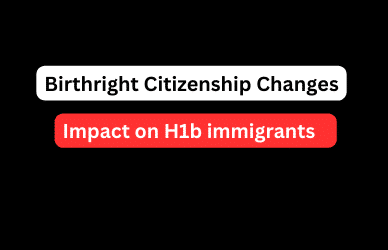Are you an H4 visa holder looking to pursue higher education in the United States? Transitioning from H4 to F1 status can open up new opportunities for academic and personal growth. This guide will walk you through the process, costs, timelines, and important considerations for changing your status from H4 to F1.
Step 1: Choose a School and Get Accepted
Before initiating the change of status process, you must:
1. Research and select accredited U.S. educational institutions
2. Apply and gain admission to your chosen school
3. Ensure the school is SEVP-certified (Student and Exchange Visitor Program)
Timeline: 3-6 months
Cost: Application fees vary by institution ($50-$150 per application)
Step 2: Obtain Form I-20
Once accepted:
1. Contact the school’s Designated School Official (DSO)
2. Provide necessary documentation (passport, current visa, financial proof)
3. Receive Form I-20 from the school
Timeline: 1-2 weeks
Cost: No direct cost (may incur shipping fees)
Step 3: Pay the SEVIS Fee
1. Visit the official SEVP website
2. Complete Form I-901
3. Pay the SEVIS fee
Timeline: Immediate
Cost: $350 (as of 2024)
Step 4: File Form I-539
1. Complete Form I-539 (Application to Extend/Change Nonimmigrant Status)
2. Gather supporting documents:
– Copy of passport
– Current visa
– I-94 record
– Form I-20
– Proof of SEVIS fee payment
– Financial documents
– Letter explaining your intent to change status
3. Pay the filing fee
4. Submit the application to USCIS
Timeline: Processing can take 3-5 months
Cost: $370 for Form I-539 (as of 2024)
Step 5: Attend Biometrics Appointment (if required)
1. Receive appointment notice from USCIS
2. Attend the appointment for fingerprinting and photo
Timeline: Usually scheduled 3-5 weeks after filing
Cost: Included in I-539 filing fee
Step 6: Await Decision
1. Check your case status online regularly
2. Respond promptly to any Requests for Evidence (RFE)
Timeline: Varies, typically 3-5 months from filing
Important Considerations:
1. Timing: File your change of status at least 60 days before your H4 status expires.
2. Maintain Status: Continue to maintain your H4 status until a decision is made on your F1 application.
3. Travel Restrictions: Avoid international travel while your application is pending.
4. Employment: H4 visa holders with work authorization must cease employment once the F1 status is approved.
5. Alternative Option: Consider consular processing if time is a constraint or if you plan to travel.
6. Start Date: Ensure your program start date is within 30 days of your current status expiration.
7. Dependents: If you have dependents, they’ll need to file separate I-539 forms.
8. Denial Risk: Be prepared for the possibility of denial and have a backup plan.
H4 to F1 FAQ Section:
Q1: Can I work on an F1 visa?
A: F1 students can work on-campus up to 20 hours per week during the school year and full-time during breaks. Off-campus work is only allowed in specific situations like Optional Practical Training (OPT) or Curricular Practical Training (CPT).
Q2: How long does the change of status process take?
A: The process typically takes 3-5 months, but processing times can vary. Check the USCIS website for current processing times.
Q3: Can I travel while my change of status application is pending?
A: It’s not recommended. Traveling outside the U.S. while your application is pending is considered an abandonment of your application.
Q4: What if my H4 status expires before my F1 status is approved?
A: As long as you file Form I-539 before your H4 status expires, you can legally remain in the U.S. while your application is pending.
Q5: Can I start studying before my F1 status is approved?
A: No, you must wait for USCIS approval before beginning your studies as an F1 student.
Q6: What if my change of status is denied?
A: If denied, you may need to leave the U.S. and apply for an F1 visa at a U.S. consulate abroad, or explore other visa options with an immigration attorney.
Q7: Can I change from H4 to F1 if I’m already studying?
A: Yes, but you must prove that you didn’t intend to study when you first entered on H4 status.
Most Common Reasons for H4 to F1 Change of Status Rejections:
Understanding why H4 to F1 change of status applications are rejected can help you avoid common pitfalls. Here are the most frequent reasons for denials:
1. Preconceived Intent:
USCIS may deny your application if they believe you had the intention to study in the U.S. when you initially entered on H4 status. To avoid this, ensure there’s a clear change in circumstances that led to your decision to study.
2. Timing Issues:
Filing too close to the expiration of your H4 status or your program start date can lead to rejection. Always file well in advance, ideally 3-4 months before your program starts.
3. Incomplete or Incorrect Documentation:
Missing documents, inconsistencies in information, or incorrectly filled forms can result in denial. Double-check all your paperwork before submission.
4. Insufficient Funds:
Failing to demonstrate adequate financial resources to support your studies and living expenses can lead to rejection. Ensure your financial documents clearly show you can cover all costs.
5. Status Violations:
Any violation of your current H4 status, such as unauthorized employment, can result in a denial.
6. Academic Qualifications:
If USCIS determines you’re not qualified for the program you’ve been admitted to, they may deny your application. Ensure your academic background aligns with your chosen program.
7. Dependent Status Issues:
If the primary H1B holder’s status is in question or terminates, it can affect the H4 dependent’s change of status application.
8. Failure to Maintain Status:
If you’ve failed to maintain your H4 status (e.g., by overstaying), your change of status application will likely be denied.
9. Misrepresentation:
Any false information or misrepresentation in your application can lead to denial and have serious immigration consequences.
10. Program Credibility:
If USCIS has concerns about the legitimacy of your chosen educational program or institution, it could lead to a denial.
To maximize your chances of approval:
– Plan well in advance
– Consult with experienced immigration attorneys or your school’s international student office
– Provide clear, consistent, and comprehensive documentation
– Be honest and transparent in all aspects of your application
Remember, while these are common reasons for rejection, each case is unique. Always seek professional advice if you have concerns about your specific situation.
Would you like me to expand on any part of this additional content?
Conclusion:
Changing from H4 to F1 status requires careful planning and attention to detail. By following these steps and considering the important factors, you can navigate the process successfully. Remember that immigration regulations can change, so always consult with your DSO or an immigration attorney for the most up-to-date information.
To get connected to top immigration experts visit www.h1bvisahub.com. On h1bvisahub portal you can ask any question to AI powered visa assistant and instantly send a contact request to an immigration advisor .
Are you considering changing your status from H4 to F1? What questions do you have about the process? Share your thoughts in the comments below!






